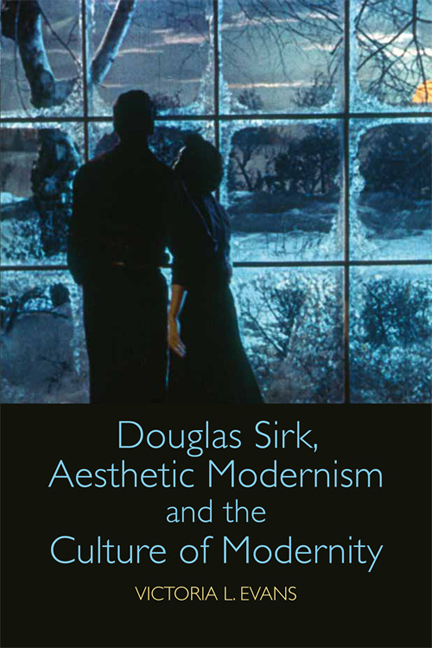Book contents
- Frontmatter
- Contents
- List of Figures
- Acknowledgements
- Introduction
- PART ONE SIRK AND THE VISUAL ARTS
- PART TWO THE SHOCK OF THE NEW: TRACES OF MODERNITY
- PART THREE TWO ARCHITECTURAL CASE STUDIES
- 5 Final Chord and ‘Die Neue Welt’: The Mise-en-scène of Aufbruch
- 6 Back to the Future: Modernist Architecture and All That Heaven Allows
- Bibliography
- Index
5 - Final Chord and ‘Die Neue Welt’: The Mise-en-scène of Aufbruch
from PART THREE - TWO ARCHITECTURAL CASE STUDIES
Published online by Cambridge University Press: 20 December 2017
- Frontmatter
- Contents
- List of Figures
- Acknowledgements
- Introduction
- PART ONE SIRK AND THE VISUAL ARTS
- PART TWO THE SHOCK OF THE NEW: TRACES OF MODERNITY
- PART THREE TWO ARCHITECTURAL CASE STUDIES
- 5 Final Chord and ‘Die Neue Welt’: The Mise-en-scène of Aufbruch
- 6 Back to the Future: Modernist Architecture and All That Heaven Allows
- Bibliography
- Index
Summary
Final Chord or Schlussakkord was the only film from Douglas Sirk's German period to depict twentieth-century urban life. In the prologue that the director added to the existing script, two antithetical aesthetics appear to underscore the philosophical and political disparities that distinguish a democratic New York from a Fascist Berlin. Since it consists of nothing but luminous skyscrapers and all-white ‘non-bourgeois’ interiors, Final Chord's Manhattan seems to represent the egalitarian ‘Neue Welt’ or ‘New World’ that had been predicted by Machine Age architects during the previous decade. By contrast, Berlin's grandiose Imperial monuments and luxurious Art Deco residences suggest a highly inequitable society that has chosen to preserve received hierarchical distinctions. Of course, given the repressive nature of the current political regime, the director could only criticise its authoritarian tendencies indirectly. Consequently, in Final Chord the architectural symbolism of each of these cities may be read both positively and negatively (from a Modernist and a National Socialist point of view). After outlining some of the most significant arguments on either side, I will then attempt to address the vexed question of which metropolis exemplifies the most desirable ‘New World’ of the future, on the basis of the formal and narrative evidence that is provided by the film itself.
In this lengthy preliminary section (which takes up more than a third of the total running time), Sirk introduces the key characters and sets out the major dramatic conflicts by cross-cutting between New York and Berlin. After a montage sequence highlighting the giddiness of Manhattan's New Year's Eve revelry, a drunken passer-by stumbles across a dead man seated on a bench in Central Park. The audience soon discovers that the well-dressed suicide was a fugitive living under an assumed name who had fled Germany after being convicted of embezzling funds from his employer. Although his wife had accompanied him into exile, they were forced to leave their young son behind. We subsequently see this engaging child being taken to an orphanage in Berlin after the police department confiscated the money that had been left with a foster mother for his care.
- Type
- Chapter
- Information
- Douglas Sirk, Aesthetic Modernism and the Culture of Modernity , pp. 115 - 146Publisher: Edinburgh University PressPrint publication year: 2017



